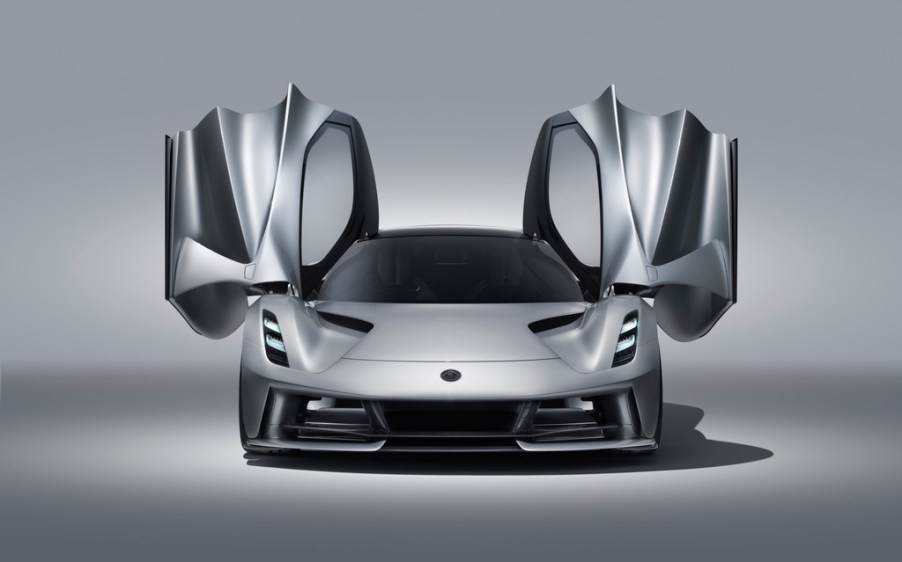
Four Awesome Facts About the Lotus Evija Electric Hypercar
Last Tuesday in London, Lotus finally unveiled its—and Britain’s—first purely electric hypercar: the Lotus Evija. Evija literally translates to “the first in existence” and it sets the bar for future models from the company, which we are sure to see in the upcoming decade. Lotus Cars CEO Phil Popham said as much at the official unveiling ceremony. “The Lotus Evija is a car like no other. It will re-establish our brand in the hearts and minds of sports car fans and on the global automotive stage,” he stated, continuing, “It will also pave the way for further visionary models.”
Bold claims, to be sure, but after taking a glimpse at the Evija, it is difficult to disagree with his promising words. The Evija is truly at the top of its class when it comes to all-electric vehicles, and some of its features are so awesome they are almost unreal. Below, we’ve chosen the top four facts about the Lotus Evija hypercar that will blow your mind.
The Design
The Lotus Evija’s design, as reported by CTV News, was inspired by “rocks that had been carved by nature over the centuries.” Instead of a more typical aerodynamic structure, the Evija’s design team took its cues not only from nature itself but also from the aeronautics industry. The Evija was built around the concept of porosity, and as Clean Technica states, “instead of trying to slice through the air, the skin of the car was shaped to encourage air to flow around and through it.”
This produces the visual impact of the surreal sleek exterior, which looks as though the skin of the car has been stretched over its body, encompassing every ridge and port to counteract the low pressure that builds up behind more traditional automotive shapes. This also reduces aerodynamic drag, increasing the efficiency and stability of the vehicle.
The Power
With a power output of roughly 1973 hp and 1254 lb-ft of torque, the Lotus Evija can accelerate from 0 to 60 mph in under three seconds. With a mind-blowing top speed of over 200 mph, the Evija demonstrates it will prove a strong competitor for both Pininfarina’s recently announced Battista and the upcoming Roadster from Tesla.
According to Lotus’ own website, “The car’s advanced aerodynamics and four-radiator cooling package keep the battery at an optimum temperature. It means that the Evija is capable of being driven flat out with no derate for at least seven minutes in Track mode.”
The Battery
Beneath its sleek exterior is a 100% all-electric four-wheel drive powertrain with a 2,000 kW battery that delivers power to four electric motors. Though consumers currently only have availability to 350 kW charging technology, soon they are hoping that 800 kW chargers become commercially available. This means that the Evija’s current charging rate of 18 minutes will be upgraded to only 9 minutes — and that’s enough juice to power the vehicle for 250 miles.
The 2,000 kW battery was designed in conjunction with Williams Advanced Engineering “as part of a joint venture with Lotus to collaborate on advanced propulsion technologies.” Lotus writes, “WAE won a 2018 Queen’s Award for Enterprise for translating its EV expertise from the race track to road-going vehicles,” and it’s clear why the car company is proud of its partner’s distinction. This fellowship will translate into the continued supply of cutting-edge technology and management systems for future EVs from Lotus—all the more promise for Lotus’ future as a leader in all-electric vehicle production.
The Interior
The interior of the Lotus Evija is a truly stunning piece of artwork on every level. Starting with the two handle-free dihedral doors which are opened using the key fob, the interior space is maximized for the driver’s pleasure. Inside you’ll find exceptional attention to detail, from the lightweight visible carbon fiber surfaces to the thin metal band—engraved with the words “For the Drivers”—at the heart of the interior, running centrally between both seats.
“The shape is inspired by the company’s prototype racing cars of the late Fifties and early Sixties,” explains Russell Carr, Design Director, Lotus Cars. “It has a beauty and an elegance to it, and represents a typically Lotus approach because it performs multiple functions.” What Carr states is an integral part of both the internal and external design of the Evija. No one component is there just for looks or just for performance; everything is dual-functioning.
After getting a chance to analyze and delve deeper into the history behind the Evija, there’s no one more excited than us to see what else Lotus has in store regarding future EVs.


